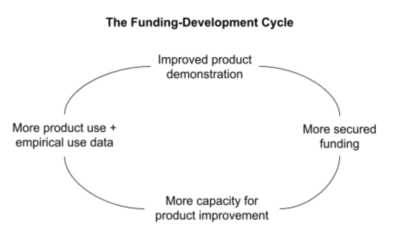Market Validation is to founding a new venture as Goji is to berry (and excellent software development.) That’s right. I said it. Validating one’s market correctly is *the* essential first step in founding any new company or developing any new product. It reveals whether there’s need and desire for the product or service, and affirms whether one should proceed with the idea or put it in their “Great But Not Right Now” Idea Box. We all have one of those.
Let’s dive in, shall we?
TLDR; Contents
Defining Market Validation
Market validation is the process of assessing one’s target market, how much one can expect to make off of that market, and whether they should invest in an idea. Sounds simple? It is. Kind of. The key questions you should look to answer revolve around:
- What do my potential customers look like?
- What are their consumer habits?
- How large is the market?
- What would my customer be willing to pay for my product?
- How does my competitive landscape look?
- What are my competitors’ strengths and weaknesses?
Answering these questions will not only equip you with critical information on what to expect from your new venture and how to tailor it to your customers as best as you can. In addition, knowing these answers will help you prove to everyone else, including your investors and your mother, why they should buy into your idea as well.
Why Market Validate?
Well, we touched on this one lightly already. At Goji, we like to refer to the “Funding-Development Cycle.” It looks like this:
When you first embark on the product development journey, it’s safe to assume that you might not have endless resources. Which is fine–that’s how most of these stories go. So the general beginning of your company is kind of like a revolving door of securing resources to improve your product to secure more resources.
The better the pitch or initial product, the more resources and funding it will receive, the better the product will become, the more funding it will win…and so on.
The goal here, then, is two-pronged: resources and traction. Building such an excellent product gains more users who attest to the market need and provide feedback for future iterations. These users and iterations propel investors to invest, which provides more resources for further improvement. Lovely.
So if the goal is traction and traction revolves around users? First, one must really get to know who their target market is, what they’re willing to spend, and why they’re willing to spend it. And that, my friend (or acquaintance, if you want to keep it casual), is where market validation comes in.
Why Do Investors Care about Market Validation?
Well, for starters, they want their money back. And then some.
Accurate and reasonable market validation provides them with the basis to understand their expected ROI. Don’t go all funky with the numbers, though—they’ll know. Investors use your market validation not only as a tool for evaluating the potential market and investment but also as a tool to evaluate you and your judgment.
They want to see that you’ve done your research and stand before them presenting qualitative and quantitative analyses on the market and target demographics—not assumptions.
As we’ve said before, assumptions are a dangerous thing in founding any venture. Baseless assumptions about their products and target market can lead founders astray, lead to bad product fit, and waste precious resources and energy. And investors know that.
How to Market Validate
Research. Research, research, research. Everything relevant and evenly seemingly irrelevant? Read it. We’ll explain.
Methods to Market Validate
There are several methods to use here, and in our humble opinion, you should use all of them.
To assess your target market, first list out what you think their group characteristics might be. These characteristics can be income, age, location, occupation, family status, or education—to name a few. You can then begin to look at their spending habits on related and unrelated products and services and how macro-level factors influence these spending habits. This can clue you into their priorities, personalities, needs, likes and dislikes, and even help narrow down their characteristics further.
From there, you can take a look at their spending on related goods and services—and figure out the bigger picture of the market.
And to confirm all of these assumptions? Create your own data with customer interviews, questionnaires, and surveys, and try to get every ounce of relevant data already out there.
5 Steps to Market Validation
A quick and easy(ish) guide to validate your market. Remember—this is a process that should be done repeatedly. Sure, it’s a critical initial step. But it should be adjusted and repeated as you release more features and iterations to assess product fit constantly.
Determine the Purpose of Study
Easy enough. What do you want to find out, and why? How will the analysis you’ll conduct and answers you’ll find help you eliminate assumptions? Be specific here.
Catalog Your Assumptions—and check them well.
Yes, yes, I know, back to the assumptions. But this really is a crucial point: we want as close to as few assumptions as possible. So in this step, outline every assumption you have that you can think of and set out to investigate and come up with a concrete conclusion instead. These assumptions can be about your market, your industry, your competitors, your product’s value proposition, and your proposed pricing strategy. Everything.
Deep Dive into Your Industry’s Outlook
Previous Trends
How has your industry changed throughout its existence? Over the last decade, five years, year? What macroeconomic factors and events have impacted it, and how have they related to its growth trends?
Macro Events that Impact Future Growth
Get creative. What are current trends and key indicators that prove your industry is expanding and that there’s room (and need) for your product’s value-add? A new invention? A new social trend? A pandemic (oy-vey)?
Again, we’re looking for concrete evidence here—not guesses. Trends can be found by looking at Bureau of Labor Statistics reports, the CIA World Book, SocialBlade, Google Trends, trade journal articles, and even the stock market of Djibouti. As long as it’s concrete evidence with concrete logic (and reasonable estimation of influence) behind it, it’s important.
Narrow Down Target Market
Refine what you think your target market might be. Segment your target demographic into personas, try to think the way they might, and then affirm (or disprove) your assumptions. Use surveys, interviews, and questionnaires, as well as already existing information, to nail down your target market. Good tools and resources here can be Gartner, Forrester, and SurveyMonkey, among many others.
Conduct Competitive Analysis
Good market validation always, always involves looking at competitors. Investigate them by checking out their products, subscribing to their newsletters, looking at their 10ks (if public), and even calling them anonymously to ask about their pricing and transaction volumes (sounds sneaky, but even Forbes recommends it.) What are their strengths and weaknesses?
If you happen to be entering a market that doesn’t yet have many competitors (look at you, you maverick!), look at related products and services: who are the people who are spending on them, and what are they spending? In that, what’s the value-add of your product in comparison to the incumbent alternatives? Time, money, efficiency? A quick Google Keywords Tool exploration of Search Terms and Related Search Terms volumes could be tremendously helpful here.
Do Market Validation Dance (The Math)
Ah, the numbers that everyone cares about. You’ve concluded that your product is a definite upgrade from what’s out there. But everyone (you, your investors, and your brother-in-law) will want to know: how much money can you make off of it?
TAM – Total Available Market
In its simplest form, the TAM is:
# People in Your Target Market X Avg of What They Are Already Paying
(do not make the mistake of multiplying # People X Your Pricing. That is highly frowned upon. And wrong.)
There are four methods of calculating the TAM.
- Top-Down: remember we talked about macroeconomic factors? Yeah. That. Basically, this approach is based on the macroeconomic factors that define a segment of customers unified by using a thing. The CIA World Factbook, World Bank, and OECD are all good resources for this one.
- Bottom-Up: this one’s regarded as a perhaps more accurate basis of assessment because of its use of primary data. This approach is based on first determining the local market size and then extrapolating it to a larger population. Its downfall: the extrapolation over varying regions might render it less reliable than one thinks.
- Value-Theory: for all of the mavericks out there, this one assesses the positive trade-offs over existing options for new products. It estimates value-add to assume potential revenue.
- External Research: Gartner, Forrester, and IDC publish reports which estimate industry TAMs. Use them, but also get your own primary research.
SAM – Serviceable Available Market
Or the segment of TAM that you can reach (hint: it is very likely not 100%. Don’t go there.) Split your TAM into different types of users by varying price, quality, and functionality. Your TAM turns into your SAM by geographic, regulatory, and cultural factors, among others.
SOM – Serviceable Obtainable Market
Market forces and your resource restraints—both financial and human capital—limit how much market share you can access. And for early-stage, estimating around 5-10% is a good ballpark. You might get funny looks if you stay 50%.
Conduct Market Validation Interviews
Identify your target customer and brainstorm how to reach them. Then ask them (very nicely) to participate in interviews, questionnaires, and surveys featuring straightforward questions that illicit minimal bias. And remember: simply liking your idea does not count as buy-in from the participant. Investigate value-add, need, and potential spend here. In the end, ask yourself: did your results validate the value-add and investment potential of your idea?
Product Testing to Ensure Product Fit and Accurate Market Validation
Building a Minimum Viable Product (MVP)
Once you’ve conducted your customer validation, you can begin to invest resources in building an MVP. An MVP is a lean, initial version of your product that offers all essential features and keeps the rest for later.
By creating a successful MVP, you can begin to gain traction, perform alpha and beta testing, and perform prototype and usability testing. Testing will help you weed out issues with the workflow, features, and branding. User testing will end in…you guessed it, more interviews. Which in turn can inform future iterations and refinements, lead to more traction and even investment. Huzzah!
Ok, we threw a lot at you here.
But the point is that in order to perform excellent market validation, you have got to research. Research like your product depends on it—because it does.
Wondering about market validation or product strategy? Want a quick chat?
Looking to develop an application in Los Angeles, New York, or literally anywhere else?
Have an app, but you’re in a slight pickle? Doing super well but looking to scale or revamp?
Have general questions about who we are and our authority on the subject?
Drop us a line at GojiLabs.com.
– Goji Labs.





